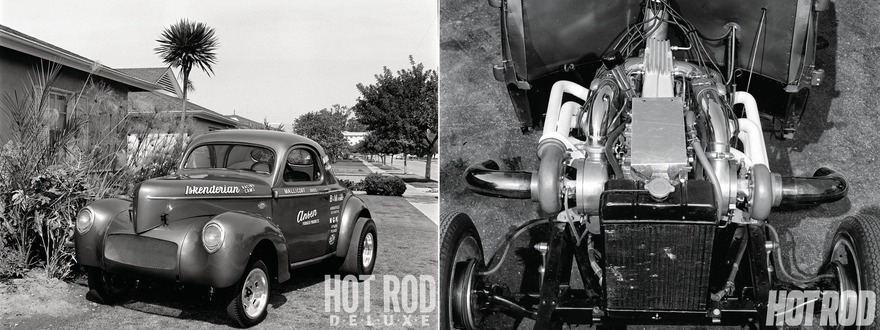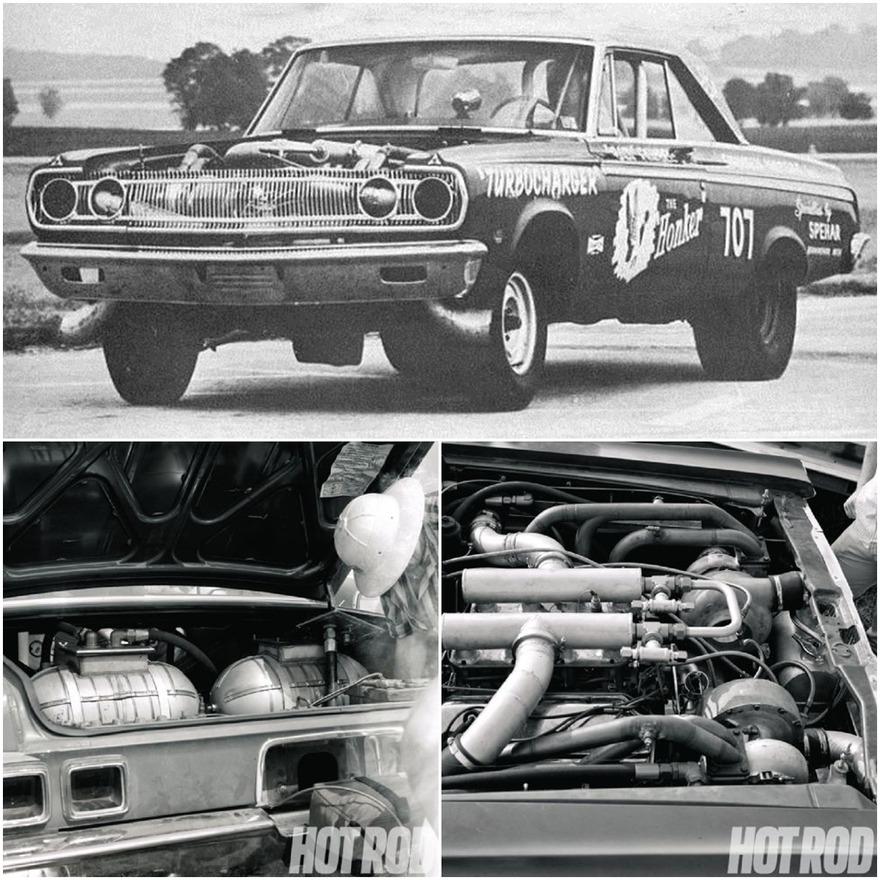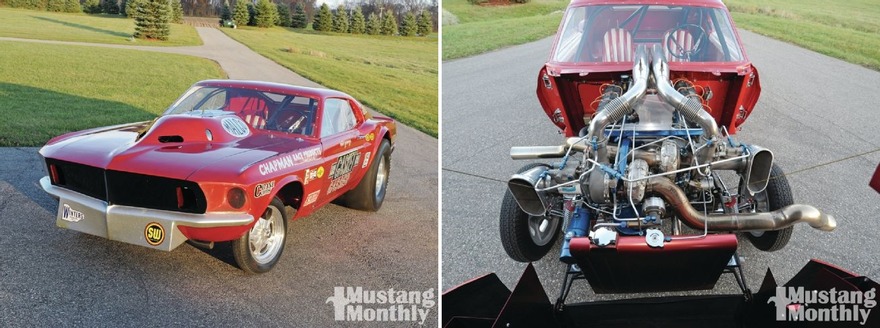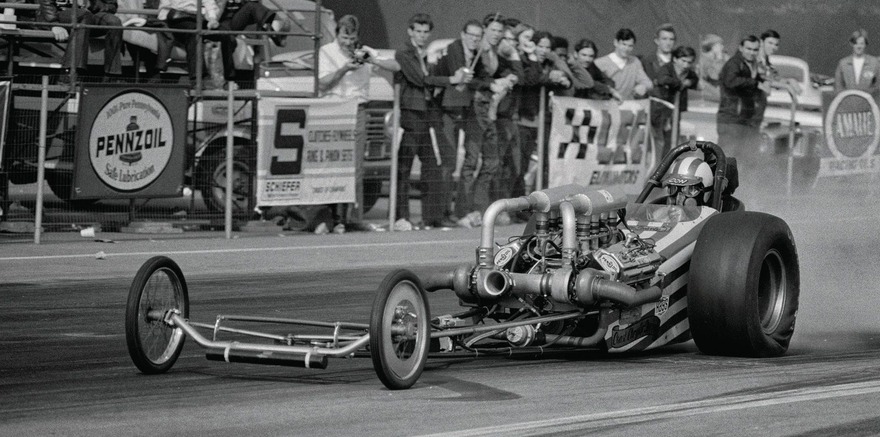In modern realities turbochargers in drag racing are nothing new. Technology run-pilots, engineers thoroughly studied and, most importantly, it works. Scope of the turbo in races on kvoter limited solely to the regulations, which in turn is often due not to efficiency and ossified and long-established traditions. How otherwise to explain, for example, lasted until the end of 2015 carbureted engines in Pro Stock class in person is difficult to me. But back to our «snail». In this publication we once again look back and tell about those times when the turbine, as they say, has not yet become mainstream, and the guys reshivshiesya on their use, it was similar to the revolutionaries.

Gary and Jerry Mallikoat in the mid-sixties already very well proven on a thematic stage by winning the 1964 Winternationals driving bought from a police officer and thoroughly modified Willys «40. But it is important what happened later in the off-season, when the brothers accidentally saw in a workshop on the dyno Ed Iskenderiana twin-turbo Small-Block Chevrolet, who was preparing for the races at Bonneville. Giving powerplant produced at Gary and Jerry are so impressed that they immediately ordered Ed 327 minutes (5.4 L) Chevrolet Small-Block with a similar configuration of the boost and set it under the hood of his Gessar. A herd of 720 head was enough to become the number one in the next Winternationals and perpetuate his car on the cover of Super Stock & Drag Illustrated. In 1968, the brothers returned to his experiments, replacing the supercharger drive in Plymouth Barracuda Funny Car at the two turbines, which made it possible to inflate the engine immediately returns to 850 to 1200 hp The best result of the car became 8.13 seconds, while the majority of their opponents showed a middle eight.

In the first half of the sixties Bad Fobel was the owner of one of the largest dealer networks Dodge on the east coast, and like many car dealers that time professed principle of „win on Sunday — Monday sold. “ This scheme allowed perfectly combine business with pleasure. In their spare time Fobel, which had to its credit inaccessible to many support factory, ruffled nerves of the opponents and beat the records in batches at the wheel of his The Honker, which every year in accordance with changes in the model range has undergone minor changes. But soon the sensations of the Super Stock technique was not enough, and then about Bad met during one Event with the driver, who was working on a turbocharged inline-six. Not difficult to guess what thoughts were in my head then Fobela: „We need to take the most powerful engine in the Chrysler product line, tie him turbine, and preferably two, and get the output machine for the destruction of everything.“ Marketers giant Detroit liked the idea immediately, and all the necessary resources were allocated immediately to create ultimatum projectile. Together with experts from the aviation industry Turbo Honker was built in the shortest possible time, and the first tests could develop astounding for those times at 160 mph kvotere. They say that giving the twin-turbo 426 Hemi with intermediate cooling system has been at the level of 1300–1500 hp that looks and did something transcendent for 1966. In other matters, the intercooler itself is located in the trunk, was also not for those years, something ordinary, to say the least. Turbo Honker disappeared from sight just as suddenly as it had appeared, and the Fobel subsequently turned his attention to the rapidly growing momentum class Funny Car.

It all started with the fact that the guys from the unit Ford Motor Company, is engaged in various motorsport activities, came to the indescribable joy of what results sought the legendary George Montgomery on the strip, using Ford engines under the hood of his Willys „33. Well, because they wanted to sell only cars with a blue oval on the grille, the bodywork of the car Montgomery them fundamentally untenable. That is how the idea of creating Gessar with fiberglass body Mustang „67. When representatives of the Technical Commission for the first time George saw the unit, they fell into a stupor, because before that in the class of race cars competing on the basis of production road cars built before the mid-fifties. But in fact there was no fault to anything, because at the heart dregster lay considerably modified frame the Willys, and he fully satisfy the regulations.
Needless to say that classical Gesser had no chance against the background of aerodynamic superiority offspring Montgomery. Culminating in 1971.
By this time the body has been replaced by a more current version of 1969, and took place under the hood seven-liter twin-turbo Boss 429. As he remembers the driver, it took him several years to properly build up boost and a mechanical fuel injection system, as well as to develop a chassis that allows to realize the enormous power of the engine, but two wins in a row at the Gatornationals in 1973–1974 years and numerous records in the class paid for all their efforts with interest. Mustang flew kvoter with an average result at the level of 8.4 seconds with an exit velocity of the order of 175 mph, and the opponents at the time could only chew on your elbows in a fit of desperation, while in 1975 George has not taken a decision to sell his brainchild. Opinions about the real power dregster vary widely, but the Montgomery somehow modestly admitted that he had to reduce the impact of the power plant by about 400 power to the car remained manageable. Today you can in good conscience say that with a light hand of the famous racer in the early seventies, the direct ancestor of modern turbocharged Pro Mod dregster was created.

Jean Adams and Don Enriquez worked together in the company Hilborn Fuel Injection, for over two decades together participated in the race and created a lot of really remarkable cars, which at one time have put a lot of rustling in the strips across America. One of them is certainly drester Top Gas class with a 6.4-liter 392 the Hemi, equipped with twin-turbo and mechanical fuel injection oddly Hilborn. Compared to the configuration with a mechanical supercharger Roots engine output was 1245 HP against 850. However, the main problem was the implementation of this power. Some experts argue that the chassis construction do not adequately realize the potential of a very capricious turbo, while the other sin the notorious turboyamu and lack of traction during launch. In any case, the car drove Gina and Don is not worse than other members of the class at the low seven seconds and 200 mph leaving the Quarter. Yes, the killer of traditional dregster he did not. But we have to admit that on the background of many unsuccessful attempts of other pilots and mechanics to outdo competitors by a pair of turbines, this example has a place in our selection of really successful implementation of the scheme in the years when turbonnaduv was a lot too daring enthusiasts ahead of time.
Photo: open source

Jean Adams and Don Enriquez worked together in the company Hilborn Fuel Injection, for over two decades together participated in the race and created a lot of really remarkable cars, which at one time have put a lot of rustling in the strips across America. One of them is certainly drester Top Gas class with a 6.4-liter 392 the Hemi, equipped with twin-turbo and mechanical fuel injection oddly Hilborn. Compared to the configuration with a mechanical supercharger Roots engine output was 1245 HP against 850. However, the main problem was the implementation of this power. Some experts argue that the chassis construction do not adequately realize the potential of a very capricious turbo, while the other sin the notorious turboyamu and lack of traction during launch. In any case, the car drove Gina and Don is not worse than other members of the class at the low seven seconds and 200 mph leaving the Quarter. Yes, the killer of traditional dregster he did not. But we have to admit that on the background of many unsuccessful attempts of other pilots and mechanics to outdo competitors by a pair of turbines, this example has a place in our selection of really successful implementation of the scheme in the years when turbonnaduv was a lot too daring enthusiasts ahead of time.
Photo: open source









